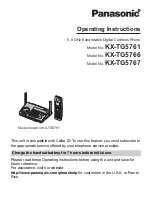
17 — English
OPERATION
DESCENDING HILLS
Check the terrain carefully for any obstacles before you
go down the hill.
Point the ATV straight down the hill. Avoid going down a
hill at an angle that would cause the vehicle to lean sharply
to one side.
Transfer your body to the rear by sliding back on the
seat.
Ride down the hill slowly with the throttle released.
Apply the rear brake to control the speed.
If your front wheel skids:
Gain front wheel traction by reducing the throttle opening and
leaning your body slightly forward.
If your rear wheel skids:
If space permits, steer in the direction of the skid. Shift your
body away from the skid slightly. Avoid using the throttle or
brakes until you regain directional control of the vehicle.
RIDING THROUGH WATER
You can ride the ATV through shallow water. Make sure it is
not more than 4 in. deep and is not moving fast. Choose a
good place to cross before you ride through the water. Look
for a spot where the banks are gently sloped on both sides
and the bottom of the stream is hard. If you are unfamiliar
with the area, park the ATV and inspect the stream first to
find a suitable spot for crossing. When crossing, operate
the ATV at a slow, steady speed. Be careful not to damage
banks when crossing.
Remember that wet brakes may have reduced stopping
ability. Test your brakes after leaving the water. If neces
-
sary, apply the brakes several times to let friction dry out
the linings.
WARNING:
Operating the ATV through deep or fast flowing water may
cause loss of traction and loss of control, which could lead
to an accident resulting in serious personal injury.
CAUTION
:
If you operate your ATV under severe conditions, it will
need brake maintenance more often than shown in the
maintenance schedule on page 20. Severe conditions in
-
clude operating under frequent full throttle or in dusty, wet,
sandy, or muddy areas.
Bring the ATV to your authorized
service center to have the brakes inspected, cleaned, and
repaired as necessary.
RIDING OVER OBSTACLES
Never attempt to ride over large obstacles such as large
rocks or fallen trees. If you come to a smaller obstacle that
you cannot avoid, you may be able to cross over it using the
following procedure.
If the obstacle is in front of you, approach it at walking
speed.
Rise up slightly on the foot rests.
Pull up on the handlebar and apply a little throttle as the
front wheels reach the obstacle.
Lean forward and release the throttle after the front wheels
are over the obstacle.
Remember that some obstacles are too high for your
ATV or for your abilities. If you are not sure that you can
safely cross over an obstacle, back up and ride around
the obstacle.
SKIDDING OR SLIDING
You may experience skidding or sliding when you are not
braking, which may cause you to lose control of the ATV. You
may also regain traction unexpectedly, which may cause the
ATV to overturn. Learn to safely control skidding or sliding by
practicing at low speeds and on level, smooth terrain.
On extremely slippery surfaces, go slowly and be very cau
-
tious in order to reduce the chance of skidding or sliding out
of control.
You may be able to overcome skidding or sliding by using
the techniques listed below.
4 inches
Содержание AT250UT
Страница 11: ...11 English FEATURES Seat Lock ...
Страница 42: ...11 Español CARACTERÍSTICAS Traba del asiento ...
Страница 64: ...987000 921 6 18 14 REV 04 ...
















































